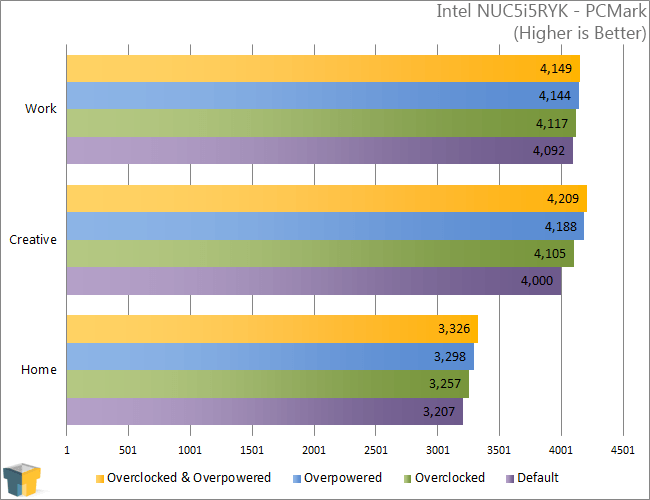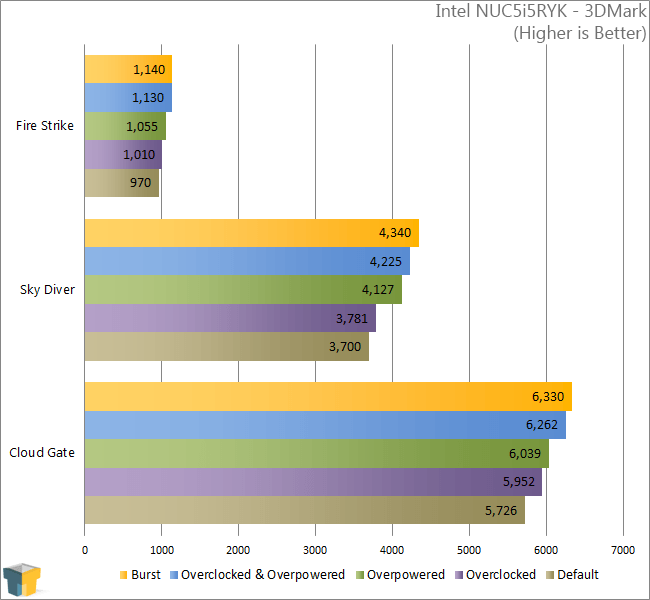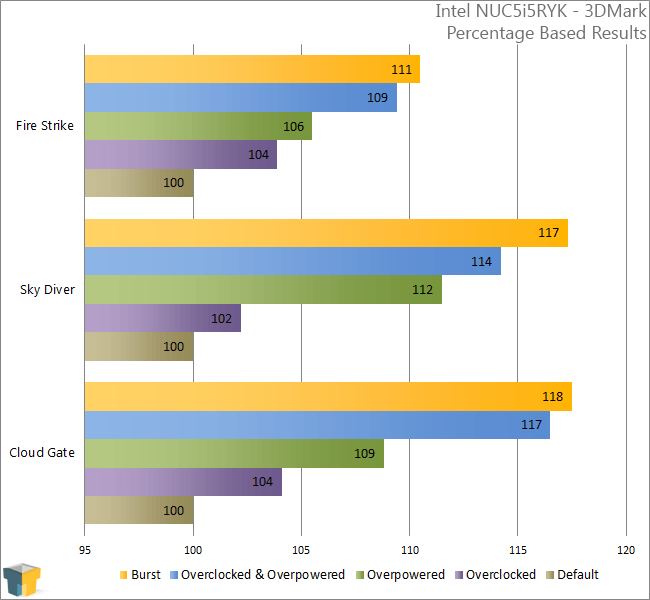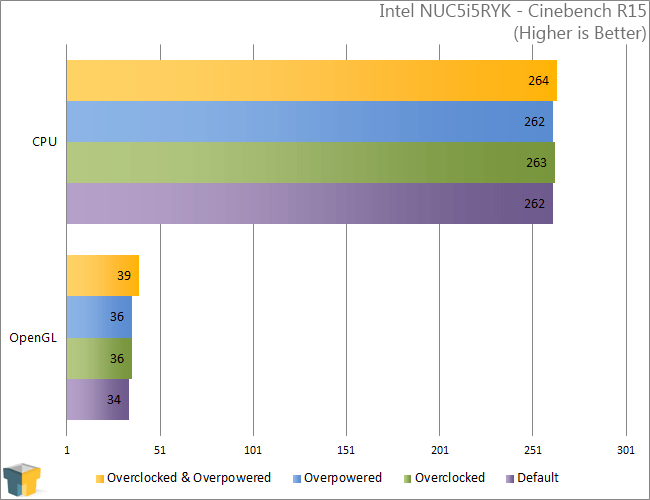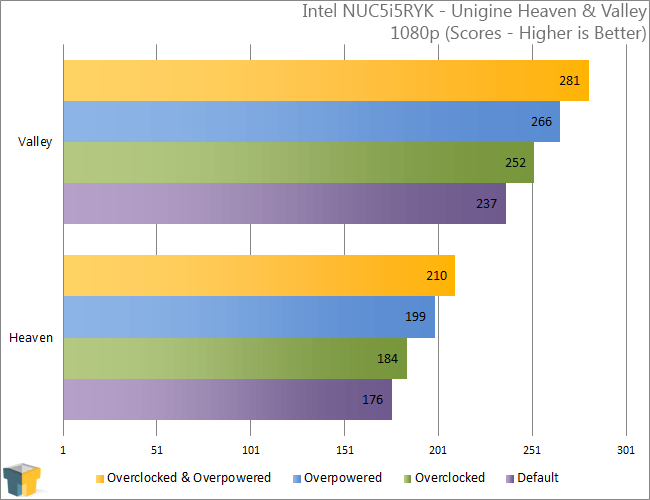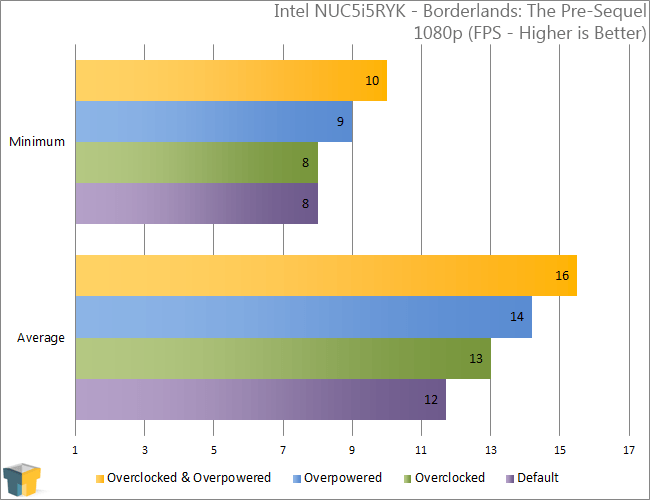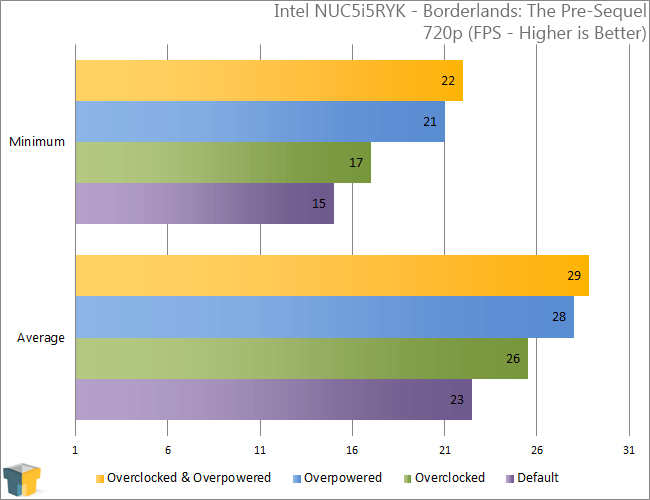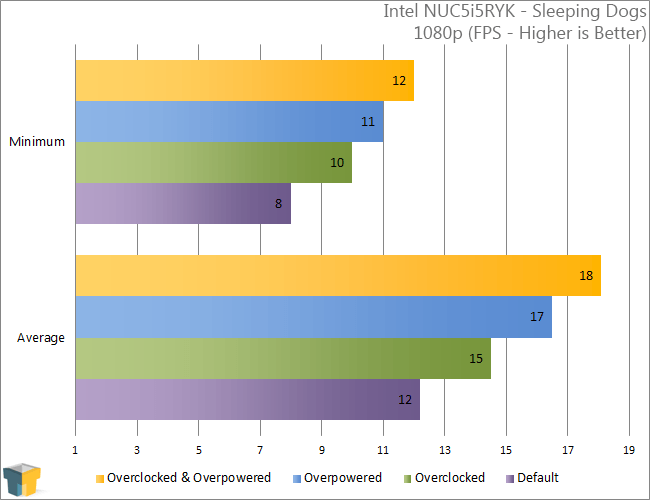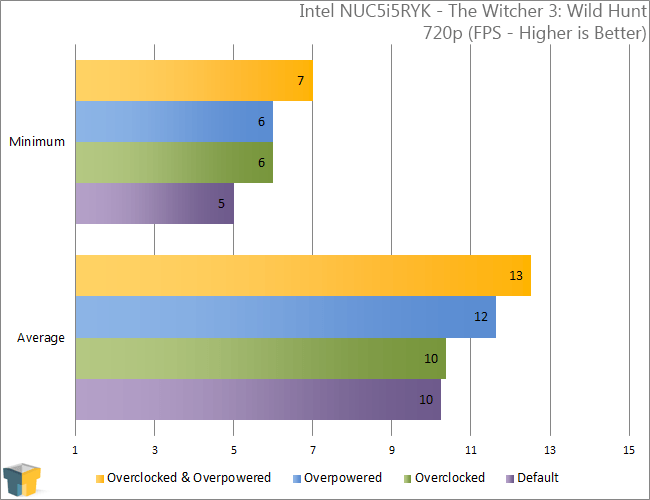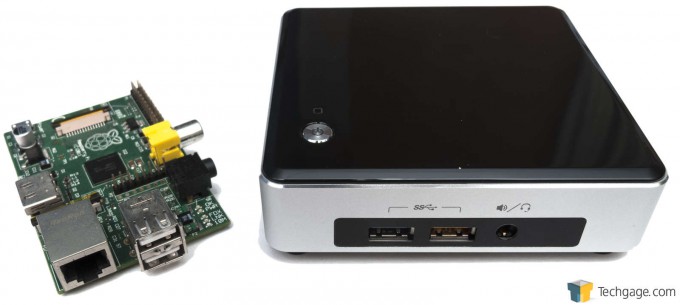- Qualcomm Launches Snapdragon 4 Gen 2 Mobile Platform
- AMD Launches Ryzen PRO 7000 Series Mobile & Desktop Platform
- Intel Launches Sleek Single-Slot Arc Pro A60 Workstation Graphics Card
- NVIDIA Announces Latest Ada Lovelace Additions: GeForce RTX 4060 Ti & RTX 4060
- Maxon Redshift With AMD Radeon GPU Rendering Support Now Available
Turning Up The Dials On Intel’s NUC – Overclock And Overpower

With our review of Intel’s NUC5i5RYK complete, it was time to have a little fun. With the power limiter unlocked, some minor memory overclocking available, and a fire extinguisher ready, we find out what the latest generation of NUCs are really capable of when the heat is on!
Page 2 – The Tests, Results and Final Thoughts
First off, we need to clarify and breakdown the results. Each test will have four tiers of results, designated by the setup. Default settings are the stock values, nothing changed apart from boot options. Memory is set to automatic with 1600MHz and 9-9-9-24-1N Timings. Power is set to automatic/higher performance, which consisted of the current limiter at 32 Amps, sustained power 20 watts and burst power at 25 Watts over 28 seconds.
Overclocked is with the memory set to 2000MHz 11-11-11-30-2N. No GPU multiplier was engaged, since after extensive testing, the results were inconclusive (there was too much variation between results, this included tests with both overclocked memory and increased power).
Overpowered results have the memory set back to automatic 1600MHz, current limiter set to 36 Amps, sustained power set to 35 Watts, and burst power set to 40 Watts over 32 seconds. In order to maintain a more consistent turbo, Processor VR Efficiency Management was disabled in EFI.
Overclocked & Overpowered – pedal to the metal, balls to the wall, full on, all out, borderline fire erupting, dials on 11, ‘show me what you got’, and a long list of other metaphors. Fire extinguisher on standby.
PCMark
We’ll start dull and look at the system performance overall with PCMark with OpenCL based compute extension. Home and Work benchmarks have less GPU components to them and so we are likely to see less of an improvement from memory clock improvements. Creative has some full 3D rendering scenes from old 3DMark versions and is much more reliant on the GPU for its score.
Due to the CPU weighting in all tests, the final outcome is less than satisfactory, double the power and 400MHz boost in memory and the best we can get is a 5% increase in the Creative workload. Look at the Work set and the total difference is just over 1% – that’s a borderline rounding error. But we didn’t come here to look at CPU weighting, so let’s move on to something a little more substantial.
3DMark
A lot of time was spent in 3DMark, as it proved the right balance of speed and hands-off approach to benching, allowing us to test out a greater variety of settings, quickly. As before in our original review, Ice Storm results have been dropped due to its wildly different results for often innocuous reasons. In addition, we’ve included a ‘burst’ result, which we’ll explain in a bit.
The memory by itself shows a good 3-4% improvement; this is not substantial, but a good indicator. Remember, things are still being held back due to lack of power, so we won’t see the real benefit. Overpowering and things become immediately obvious, this is what one would expect from overclocking, ranging from 5-10% in improvements. Letting the CPU reach a higher turbo certainly helps. Of course, throwing the kitchen sink at the NUC and we see an average 15% improvement. So what’s this burst about?
Remember when I said there was a burst power setting, an extra 5 Watts above the sustained… well, we can show that easily with 3DMark by removing the demo intro and letting each benchmark run straight away without a warm-up. That extra 32 seconds of 5 Watts is enough to push the results even higher, adding an extra couple percent to each result.
In the real world, those 32 seconds would be useful for image editing or short archiving jobs. Apart from that though, and it’s not so useful; I don’t know many games you can play in 32 seconds.
Cinebench R15
Now this is a good indicator of isolated benefits. With both GPU and CPU based benches separated, we can see the real benefits of each action.
Well this certainly helps with things. Memory alone adds 5%, overpowering adds 5%, but put them together and we get a total of 15% improvement in OpenGL rendering. The phrase ‘greater than the sum of its parts’ springs to mind. This also shows that memory alone has little effect on CPU based tasks. With everything on, and the CPU based rendering only improves by a total of less than 1%… that GPU shows how much of power hog it can be.
Unigine Heaven and Valley
Finishing off our synthetic tests we have the groundbreaking tessellation masterpiece that is Heaven, and the Skyrim open-world simulator, Valley. These are much more GPU weighted than many of the other tests, so these will again be a good indicator for overall system performance gains.
It’s subtle when you look at the results like that, but when you go by percentages, that’s 5% memory and 10% power resulting in a near 20% overall boost. Minimum and average framerates are available from the Google source document in the Final Thoughts if you are interested.
The Games
Synthetics are great, but they don’t always show us the whole picture. They are often meant to be balanced where as the real world is not, so we always like to make sure to include some real-world benchmarks. While some of the results will carry on with what we’ve seen so far, some may not.
Borderlands: The Pre-Sequel
This is why we include real-world results. Spirits have to be dampened somewhat since the frame rates are quite low as is for 1080p, but as a percentage increase, we’re looking at 10% memory, 20% power and 30% overall, give or take a few percent either way. At 720p, 28-29 frames per second is completely playable – in fact, we’re talking console territory here. A tiny little computer pumping out frames like a console with less than half the power, that’s quite the achievement. Just a shame it’s only a single game.
Sleeping Dogs
Again, when you look at the percentage increase, things get silly, 50% improvement? Really? But when you see that’s 18 FPS, it’s still not even remotely playable. I would have liked to include 720p results but just didn’t have the time in the end. However, I can attest that, much like Borderlands, it does become playable when you drop the resolution. Not bad, not bad at all.
The Witcher 3: Wild Hunt
And so, we bring out the heavy hitter, the big guns. After all our effort, all the tweaking, the blood, sweat, tears, and an empty fire extinguisher, can we get the latest Witcher title to a state of playability?
No… not even slightly…
Yup, that’s right, two whole frames. We’ve gone from vacation slideshow to graduate presentation, 20% faster but still wondering what to make for dinner. While it ends our expedition on a bit of downer, we can look back on what we’ve achieved.
Final Thoughts
First off, I would encourage you to look through our results to see the granularity, the extra percentiles if you wish, rather than rounding off the numbers. If you want to get more out of your NUC, you can, plain and simple. It doesn’t require a huge amount of effort, as long as you remain considerate of the results you aim to achieve.
If you intend to play games, the extra frames will certainly help. If your memory is up to the task, that alone will grant you an extra frame or two, but obviously, the real benefit comes from cranking up the power.
For long-term, I would not recommend the settings outlined previously, but instead be slightly more conservative. Don’t go over 35 Amps on the current limiter, as you really will push the danger zone on temperatures (I did see 95C at one point with 36 Amps, and 102C at 37 Amps, although this later caused full thermal shutdown; this is with the fan at 100%). Just bumping up the sustained power should suffice, without worrying about burst power, since gaming will always use full power and the burst won’t last. Combine both power and memory, and you can achieve some impressive results.
Outside of multimedia and gaming, there is little point to faster memory and more power. As seen with the CPU results with Cinebench, 2 points is nothing compared to the extra resources thrown at the system. Same for the PCMark results, small gains for doubling the power. But this brings us back to what the power actually does, increased stability of the CPU turbo when the GPU is engaged, that’s it.
With all said and done, the already impressive NUC5i5RYK can achieve even more impressive feats by taking it out of its comfort zone. If you are prepared to put up with the noise for some extra multimedia enhancements, turn up them dials and see what the NUC is truly capable of.
Support our efforts! With ad revenue at an all-time low for written websites, we're relying more than ever on reader support to help us continue putting so much effort into this type of content. You can support us by becoming a Patron, or by using our Amazon shopping affiliate links listed through our articles. Thanks for your support!




